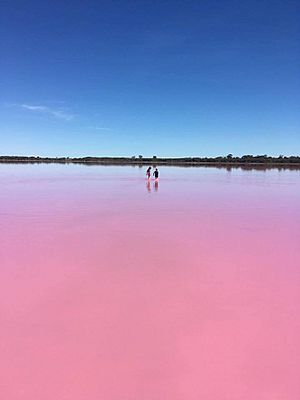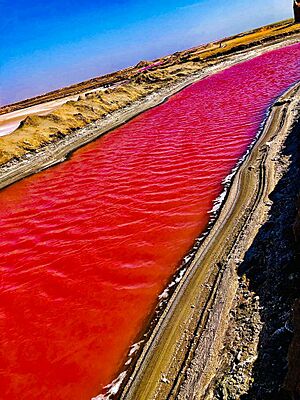Pink lake facts for kids



A pink lake is a lake that looks red or pink! This amazing color usually comes from tiny living things like algae, bacteria, and archaea. These tiny organisms love salty water and make special colors called carotenoids. One common alga is Dunaliella salina. Also, certain bacteria and archaea, like Halobacterium salinarum, often help create the pink color.
Contents
Why Are They Pink?
Pink lakes get their unique color from a mix of things. These include the climate, the land they are on, and especially how salty the water is. For a long time, people thought the color came only from a green alga called Dunaliella salina. But now we know that tiny bacteria and archaea also play a big part.
The Role of Algae
Dunaliella salina is a super salt-loving alga. It can grow in water that is 35 times saltier than the ocean! This tiny green alga is very important for life in super salty places around the world.
When there's lots of salt, warm weather, and bright sunlight, this alga makes a red color called beta-carotene. This is the same stuff that makes carrots orange! Beta-carotene acts like a sunscreen for the alga. It protects the green chlorophyll inside, making the alga look orange or red. This alga was named after Michel Félix Dunal, who first noticed that an organism caused the red color in some salt lakes in France.
The Role of Bacteria and Archaea
Some bacteria and archaea also make a special color inside their cells. This color can add to the pink hue or even be the main reason for it.
In many of Australia's pink lakes, a red bacterium called Salinibacter ruber might be involved. In 2015, scientists studied Lake Hillier in Western Australia. They found only a tiny bit of D. salina. But S. ruber made up a big part of the living things in the lake. They also found many other types of salt-loving bacteria and archaea. Nearly all of them had some pink, red, or salmon-colored pigment.
Scientists think that S. ruber might cause the color in all pink lakes, not just D. salina. But it's hard to prove because bacteria are so much smaller than algae. S. ruber makes a color called bacterioruberin. This helps it use light for energy, similar to how plants do photosynthesis. This color is spread throughout the bacterium's whole cell, which makes it more likely to color the lake.
The archaea Halobacterium salinarum is also pink. It often grows in the salt crust at the bottom of lakes. This archaea helps color some pink lakes, like the one in Melbourne's Westgate Park. The exact color of a lake depends on the balance between D. salina and H. salinarum, and how much salt is in the water.
What Makes Them Special?
Most pink salt lakes change their color. This often depends on how much rain falls. For example, a lake in Westgate Park, Australia, turned pink in March 2017 and again in September 2019. But by January 2022, it was dark green. Warmer weather and less rain seem to make it turn pink. As water dries up, the saltiness increases. But saltiness isn't the only thing. The mud and tiny living things in the lake also affect its color and the shade of pink it becomes.
Pink lakes like Lake Hillier can be ten times saltier than the ocean! (The Dead Sea is about nine times saltier.) It is safe to swim in pink lakes. However, it's not a good idea to drink the water. It's too salty for your body, and there might be tiny living things that could make you sick.
Where Can You Find Pink Lakes?
Pink lakes are found all over the world! Here are some examples:
Africa
- Kleinzee Yacht Club in Kleinzee, Northern Cape, South Africa
- Lake Natron near Mount Kilimanjaro, Tanzania
- Lake Magadi in the Kenyan Rift Valley, Kenya
- Lake Retba or Lac Rose, in Senegal
Americas
- Dusty Rose Lake in British Columbia, Canada
- Laguna Colorada, Bolivia
- On the Yucatán Peninsula, Mexico
Asia
- Aralsor, Kazakhstan
- Burlinskoye, Altai Krai, Siberia, Russia
- Koryakovka (lake), Kazakhstan
- Krasnovishnevoye, Novosibirsk Oblast, Russia
- Lipar Pink Wetland in Chabahar, Sistan, Iran
- Lonar Lake in Maharashtra, India
- Malinovoye, Altai Krai, Siberia, Russia
- Masazirgol (Masazir Lake), near Baku, Azerbaijan
- Maharloo Lake near Shiraz, Iran
Australasia
- Champagne Pool, Waiotapu thermal region, New Zealand
- Hutt Lagoon in midwest Western Australia, covering 70 square kilometers
- Lake Bumbunga near Lochiel, South Australia
- Lake Grassmere, near Marlborough, New Zealand
- Lake Hillier in the Recherche Archipelago, Western Australia
- Pink Lake (Western Australia) near Esperance
- Pink Lake (Quairading), at Badjaling, near Quairading, WA
- Pink Lake (Victoria) in the Murray-Sunset National Park, in the state of Victoria, Australia
Europe
- Koyashskoye Salt Lake, on the southern coast of Kerch Peninsula, Crimea, Ukraine
- Las Salinas de Torrevieja, near Torrevieja in Alicante province, Spain
- Lake Lemuria, in the Kherson region of Ukraine
- Les Salins d'Aigues-Mortes, in the Camargue in France
- Pačir lake, Bačka Topola, Serbia


